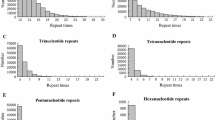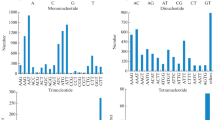Abstract
The distribution, putative function and polymorphism characteristics of simple sequence repeats (SSRs) in P. yezoensis transcriptome were analyzed in this study. In tota., 307. SSRs were detected among 2681 unigenes. Trinucleotide types were dominant, constituting 91.87% of all the microsatellites. The most abundant SSR was CCG (71.03%) and the second abundant one was AGC (234, 7.61%). A total of 111 (3.61%) dinucleotide types were found and the most abundant one was AC (51, 1.66%) which was followed by CG (34, 1.11%). SSRs identified showed a GC bases preference; GC bases constituted 89.73% of all the SSR bases. SSRs occurrence number decreased as repetitions increased. Annotation results exhibited that the majority of SSRs-containing unigenes have the functions of ‘metabolic process’, ‘binding’ and ‘catalytic activity’ and existed as the forms of ‘cell’, ‘cell component’ and ‘organelle’. The dominant amino acids that SSRs coded were Ala (28.59%), Arg (26.02%), Gly (14.35%) and Pro (13.65%). Amplification results showed that 3 out 23 SSRs from transcriptome (13.04%) and 8 out 77 SSRs from genome (10.39%) were polymorphic.
Similar content being viewed by others
References
An, Z., Gao, C. H., Li, J. N., Fu, D. H., Tang, Z. L., and Ortegón, O., 2011. Large-scale development of functional markers in Brassica species. Genome, 54: 763–770.
Asadi, A. A., and Monfared, S. R., 2014. Characterization of EST-SSR markers in durum wheat EST library and functional analysis of SSR-containing EST fragments. Molecular Genetic and Genomics, 289: 625–640.
Bi, Y. H., Wu, Y. Y., and Zhou, Z. G., 2014. Genetic diversity of wild population of Pyropia haitanensis based on SSR analysis. Biochemical Systematics and Ecology, 54: 307–312.
Biswas, M. K., Xu, Q., Mayer, C., and Deng, X. X., 2014. Genome wide characterization of short tandem repeat markers in sweet orange (Citrus sinensis). PLoS One, 9(8): e104182.
Choi, S., Hwang, M. S., Im, S., Kim, N., Jeong, W. J., Park, E. J., Gong, Y. G., and Choi, D. W., 2013. Transcriptome sequencing and comparative analysis of the gametophyte thalli of Pyropia tenera under normal and high temperature conditions. Journal of Applied Phycology, 25: 1237–1246.
Hans, E., 2004. Microsatellites: Simple sequences with complex evolution. Nature Review Genetics, 5: 435–445.
Im, S., Choi, S., Hwang, M. S., Park, E. J., Jeong, W. J., and Choi, D. W., 2015. Denovo assembly of transcriptome from the gametophyte of the marine red algae Pyropia seriata and identification of abiotic stress response genes. Journal of Applied Phycology, 27: 1343–1353.
Kalia, R. K., Rai, M. K., Kalia, S., Singh, R., and Dhawan, A. K., 2011. Microsatellite markers: An overview of the recent progress in plants. Euphytica, 177: 309–334.
Kantety, R. V., Rota, M. L., Matthews, D. E., and Sorrells, M. E., 2002. Data mining for simple sequence repeats in expressed sequence tags from barley, maize, rice, sorghum and wheat. Plant Molecular Biology, 48: 501–510.
Kashi, Y., and King, D. G., 2006. Simple sequence repeats as advantageous mutators in evolution. Trends in Genetics, 22(5): 253–259.
Katti, M. V., Ranjekar, P. K., and Gupta, S. V., 2001. Differential distribution of simple sequence repeats in eukaryotic genome sequences. Molecular Biology and Evolution, 18(7): 1161–1167.
Li, Y. C., Korol, A. B., Fahima, T., and Nevo, E., 2004. Microsatellites within genes: Structure, function, and evolution. Molecular Biology and Evolution, 21(6): 997–1007.
Liu, F. L., Hu, Z. M., Liu, W. H., Li, J. J., Wang, W. J., Liang, Z. R., Wang, F. J., and Sun, X. T., 2015. Distribution, function and evolution characterization of microsatellite in Sar-gassum thunbergii (Fucales, Phaeophyta) transcriptome and their application in marker development. Scientific Reports, 6: 18947.
Luiz, R. H., Tatiana, C., Luis, E. A. C., Luciana, L. B., Anete, P. S., Maeli, M., Sergio, A. M. C., Alisson, F. C., Luciano, C., Eduardo, F. F., Marcos, V. B. M. S., Siu, M. T., and Maria, L. C. V., 2007. Development, characterization, and comparative analysis of polymorphism at common bean SSR loci isolated from genic and genomic sources. Genome, 50: 266–277.
Mun, J. H., Kim, D. J., Choi, H. K., Gish, J., Debellé, F., Mudge, J., Denny, R., Endré, G., Saurat, O., Dudez, A. M., Kiss, G. B., Roe, B., Young, N. D., and Cook, D. R., 2006. Distribution of microsatellites in the genome of Medicago truncatula: A resource of genetic markers that integrate genetic and physical maps. Genetics, 172: 2541–2555.
Rajeev, K. V., Andreas, G., and Mark, E. S., 2005. Genic microsatellite markers in plants: Features and applications. Trends in Biotechnology, 23(1): 48–55.
Reddy, R. N., Madhusudhana, R., Mohan, S. M., Chakravarthi, D. V. N., and Seetharama, N., 2012. Characterization development and mapping of unigene-derived microsatellite markers in sorghum. Molecular Breeding, 29: 543–564.
Sharma, R. K., Bhardwaj, P., Negi, R., Mohapatra, T., and Ahuja, P. S., 2009. Identification, characterization and utilization of unigene derived microsatellite markers in tea (Camellia sinen-sis L.). BMC Plant Biology, 9: 53.
Stackelberg, M., Rensing, S. A., and Reski, R., 2006. Identification of genic moss SSR markers and a comparative analysis of twenty-four algal and plant gene indices reveal species-specific rather than group-specific characteristics of microsatellites. BMC Plant Biology, 6: 9.
Sun, P. P., Mao, Y. X., Li, G. Y., Cao, M., Kong, F. N., Wang, L., and Bi, G. Q., 2015. Comparative transcriptome profiling of Pyropia yezoensis (Ueda) M. S. Hwang & H. G. Choi in response to temperature stresses. BMC Genomics, 16: 463.
Temnykh, S., DeClerck, G., Lukashova, A., Lipovich, L., Cartin-hour, S., and McCouch, S., 2001. Computational and experimental analysis of microsatellites in rice (Oryza sativa L.): Frequency, length variation, transposon associations, and genetic marker potential. Genome Research, 11: 1441–1452.
Tóth, G., Gáspári, Z., and Jurka, J., 2000. Microsatellites in different eukaryotic genomes: Survey and analysis. Genome Research, 10: 967–981.
Victoria, F. C., Maia, L. C., and Oliveira, A. C., 2011. In silico comparative analysis of SSR markers in plants. BMC Plant Biology, 11: 15.
Wang, H. B., Jiang, J. F., Chen, S. M., Qi, X. Y., Peng, H., Li, P. R., Song, A. P., Guan, Z. Y., Fang, W. M., Liao, Y., and Chen, F. D., 2013. Next-generation sequencing of the Chrysanthemum nankingense (Asteraceae) transcriptome permits large-scale unigene assembly and SSR marker discovery. PLoS One, 8(4): e62293.
Xie, C. T., Li, B., Xu, Y., Ji, D. H., and Chen, C. S., 2013. Characterization of the global transcriptome for Pyropia haitanen-sis (Bangiales, Rhodophyta) and development of cSSR markers. BMC Genomics, 14: 107.
Yan, X. H., and Aruga, Y., 2000. Genetic analysis of artificial pigmentation mutants in Porphyra yezoensis Ueda (Bangiales, Rhodophyta). Phycological Research, 48: 177–187.
Yoji, N., Naobumi, S., Masahiro, K., Nobuhiko, O., Motoshige, Y., Yuya, S., Masataka, S., Yoshiya, F., Koji, S., Atsumi, T., Takanori, K., Ichiro, N., Fuminari, I., Kazuhiro, N., Motohiko, S., Tokio, W., Satoru, K., Kiyoshi, I., Takashi, G., and Ka-zuho, I., 2013. The first symbiont-free genome sequence of marinered alga, susabi-nori (Pyropia yezoensis). PLoS One, 8(3): e57122.
Acknowledgments
This work was supported by the National Natural Science Foundation of China (Nos. 31372517, 31672641), the Scientific and Technological Innovation Project Financially Supported by Qingdao National Laboratory for Marine Science and Technology (No. 2015ASKJ02), the Project of National Infrastructure of Fishery Germplasm Resources (No. 2016DKA30470), Fundamental Research Funds for the Central Universities (Nos. 201762016, 201562018, 201564009), and the Program for Chinese Outstanding Talents in Agriculture Scientific Research.
Author information
Authors and Affiliations
Corresponding author
Rights and permissions
About this article
Cite this article
Liu, Y., Pan, X., Xu, K. et al. Distribution, Function and Polymorphism Characteristics of Microsatellites in Pyropia yezoensis Transcriptome. J. Ocean Univ. China 18, 693–700 (2019). https://doi.org/10.1007/s11802-019-3817-6
Received:
Revised:
Accepted:
Published:
Issue Date:
DOI: https://doi.org/10.1007/s11802-019-3817-6




